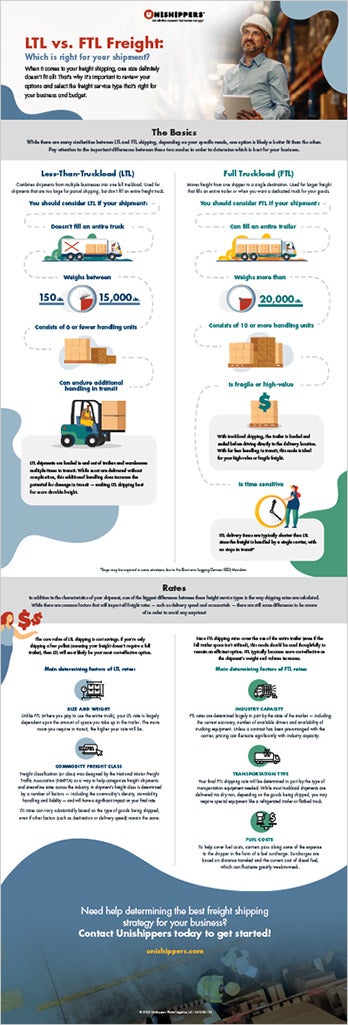LTL vs FTL: Guide To Comparing Freight Shipment Service Types
While there are many similarities between less-than-truckload (LTL) and full truckload (FTL) freight shipping, depending on your specific needs, one option is likely a better fit than the other. Download our "Truckload vs. LTL Freight" infographic to learn the differences between these two modes and determine which is right for your business shipping.
What's the difference between LTL shipping and FTL shipping?
LTL stands for less-than-truckload shipping. This option is used when shippers have a lower freight volume that can't fill an entire trailer, but still want their goods to hit the road right away. If your small or mid-sized business (SMB) is in need of cost-effective freight services, LTL shipping could be the perfect option.
Full truckload, also known as FTL freight, is a shipment type used when your freight can fill an entire truck (or if you simply need a dedicated truck for your goods). This is a great option if you're dealing with freight that fills an entire trailer, contains fragile or high-value materials or needs to arrive quicker than usual. Read about our FTL freight shipping services to learn more or get a quote today.
When it comes to LTL vs FTL, the best choice for your business may seem clear when looking at these two freight modes, but in many cases there's more to consider than shipment size alone. Our infographic details other essential FTL and LTL freight differences you'll want to understand before making a decision.
FTL or LTL Freight: Choosing the right freight mode
When choosing between FTL and LTL shipping, consider the following:
- Is the shipment large enough to fill an entire truck?
- Will the shipment be going to a single location?
- Does the shipment contain fragile or high-value items?
- How many handling units will the shipment contain?
- What is the total weight of the shipment?
By understanding the subtle differences between LTL and FTL freight, you can make the best, most cost-effective choice for your business. Download our helpful infographic to decide which shipping method best suits your business's unique shipping needs.
Still wondering which mode is right for you? Check out our LTL vs FTL FAQs below
Using an entire truck for shipping freight, known as Full Truckload (FTL) shipping, is a strategic choice when you've got enough products to nearly fill the truck. This approach minimizes multiple stops, ensuring faster delivery times and reduced handling, which decreases the risk of damage. FTL shipping is particularly efficient when transporting high-value or delicate items. Furthermore, it proves to be cost-effective when the shipment's freight class and volume justify the use of the entire trailer space. Utilizing FTL is also advantageous for maintaining optimal efficiency in your logistics operations.
One disadvantage of Full Truckload (FTL) shipping is the higher costs involved, especially for smaller shipments that don't fully utilize the trailer space. Additionally, committing to an entire truck can lead to inefficiencies if your freight volume doesn't consistently match the truck's capacity, resulting in potential cost wastage. The flexibility for delivery dates and times can also be more rigid compared to LTL (Less Than Truckload) shipping, as FTL shipments typically follow a stricter schedule to optimize the driver's route and trailer usage. Finally, an FTL shipment may not be as economical for shippers who don’t have regular, large-volume shipping requirements.
Less-than-truckload (LTL) shipping comes with a few disadvantages that businesses should consider. A significant drawback is the longer delivery times compared to Full Truckload (FTL) shipping because an LTL shipment often involves multiple stops and handling by LTL carriers. This can increase the risk of damage to your goods during the shipping process. Additionally, managing multiple pick-ups and deliveries with different delivery dates can complicate logistics and increase administrative workload. LTL rates also tend to vary widely based on the shipment's freight class, volume, and distance, making it harder to predict costs. Finally, smaller shipments might not always be cost-effective if they don’t optimize the trailer space efficiently.
LTL shipping can provide total cost savings for businesses by allowing multiple shippers to share trailer space, reducing the cost per shipment. Even though LTL rates can vary widely based on factors like the shipment's freight class, delivery date and delivery location, strategically utilizing this method for smaller shipments can lead to significant cost savings. Businesses need to carefully evaluate their shipping needs against LTL quotes to optimize their shipping budget effectively. Properly packaged goods can also ensure that shipments are classified correctly, contributing to further savings.
Understanding the freight classification system is crucial for LTL shipments because it directly affects LTL rates and shipping costs. The system categorizes freight based on factors like density, stowability, handling, and liability. Properly packaged goods with exact commodity specifications can be assigned a more favorable freight class, potentially lowering shipping costs. Being well-versed in this system helps businesses to ensure their shipments are classified correctly and cost-effectively. Most shipments benefit from an accurate classification, significantly impacting overall costs.
LTL shipping can accommodate flexible delivery dates and locations, but it requires careful coordination. Because LTL shipments involve multiple carriers and shippers, managing delivery appointments and ensuring timely delivery to various locations can be complex. Despite this complexity, LTL shipping remains a cost-effective solution for companies that do not consistently fill a whole truck and can plan around more flexible schedules. Businesses can sometimes achieve additional savings with volume LTL, which allows for more flexible deliveries and optimizing shipping routes.
LTL shipments ensure goods reach their final destination efficiently through a coordinated network of LTL carriers who manage multiple shippers' freight within the same trailer. This method allows for optimized routes and shared trailer space, making the entire shipping process more cost-effective even with multiple deliveries. By leveraging the same truck or trailer for several smaller shipments, LTL ensures that each consignment is delivered to its final destination with careful scheduling and routing. Understanding how freight takes priority and the role of delivery dates in LTL planning is essential for effective shipping strategies.




